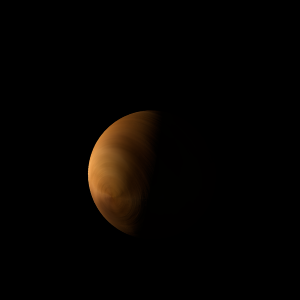|
|
Space Astro
|
Info for exoplanet "Charilene"
| Scientific (actual) data |
|---|
| Planet | KELT-11 b |
| Planet status | Confirmed |
| Planet mass | 0.195 |
| Radius | 1.3 |
| Orbital period | 4.73653 |
| Semi major axis | 0.06229 |
| Orbit eccentricity | 0 |
| Inclination | 85.8 |
| Discovered | 2016 |
| Updated | 2022-09-02 |
| Tzero tr | 2457440 |
| Tzero tr sec | 2457060 |
| Impact parameter | 0.36 |
| K | 18.5 |
| Temperature (kelvin) | 1712 |
| Publication | Published in a refereed paper |
| Detection type | Primary Transit |
| Mass detection type | Radial Velocity |
| Radius detection type | Primary Transit |
| Molecules | H2O, Na |
| Star name | KELT-11 |
| Right ascension | 161.71° |
| Declination | -9.4° |
| Mag v | 8 |
| Star distance | 98 |
| Star metallicity | 0.18 |
| Star mass | 1.438 |
| Star radius | 2.72 |
| Star sp type | G8 |
| Star temperature | 5370 |
| Star alternate names | HD 93396 |
| Wikipedia article | KELT-11 b |
Back
| |
| Fictional info (?) |
|---|
| Suggested name | Charilene |
| Planet type | Small hot gas planet |
| This planet is named after the deity Charilene, the demon of the sky.
The planet telescopically displays the complete range of phases, similar to Venus and the Moon, as it moves in its inner orbit relative to KELT-11, which reoccurs over the so-called synodic period approximately every 133 days.
Charilene's surface appears slightly rippled and is similar in appearance to the Moon's, indicating that it has been geologically inactive for billions of years.
The smooth Borealis basin in the northern hemisphere covers 14 percent of the planet and may be a giant impact feature.
There are ongoing investigations assessing the past habitability potential of Charilene, as well as the possibility of extant life. |
| Atmosphere | Na | 96% |
| H2O, | 3.7% |
| Atmospheric pressure | 90 bar |
 |
| Moon | Kinlene Laoskoll | Medium-sized irregular gaseous comet |
| Panlene Pepaada | Large potato shaped rocky asteroid |
| Halimos Keviga | Very small irregular gaseous comet |
| Google search for Charilene |
|
Website by Joachim Michaelis
|
|
|
|